The textile industry in Sri Lanka and all over the world engages in the complicated process of garment manufacturing. Gone are the times where the apparel industry had to rely on tailors and businessmen and with the advent of garment manufacturing factories, the production rates sky-rocketed. This paved way for the mass production of ready-made garments and up to date, the garment industry continues to develop new and improved techniques, machinery and processes for an effective garment manufacturing process.
A single piece of garment has to undergo several procedures before it is dispatched for shipment. In order to ensure that the production process runs smoothly, it is extremely important to follow a sequenced order. This enables us to understand the entire process of garment manufacturing and also know all about the raw materials which are artfully converted into wearable clothes.
Below is a complete course of action of a basic garment manufacturing process.
- Design
The design for any garment is provided by the buyer. The buyer places the order and then sends a technical sheet and complete art-work to the merchandiser. The design is then developed both, manually and also by using the computer.
- The making of patterns
After following the technical sheet and art-work provided by the buyer, the pattern of every garment style will be made and this is also done by either using a computerized method or manually.
- Fit Sample Making
The primary target of making a fit sample is to follow all the detailed instructions about the style of that particular garment. Upon completion of this stage, it is send to the buyer who will rectify any errors and this is a manual process.
- Production Pattern Making
For bulk production of garments, allowance is added with net dimension and the production pattern making is done either manually or through a computer.
- Grading
In the event of an order confirmation, the buyer makes suggestions about the size ratio of that order and accordingly, it will graded as per the buyer’s instructions. This is done manually or by a computer.
- Marker Making
A marker is a very thin piece of paper that contains all the components of the garment. In order to make the cutting process easier, this process is implemented either manually or via computers.
- Fabric Spreading
In order to cut the fabric appropriately, the fabric is spread in lay form.
- Fabric Cutting
According to the market of the garments, the fabric is then cut and the fabric cutting process is done manually or as a computerized method.
- Sorting of fabric and bundling
The pieces that have been cut will now be sent to be sorted out or made into a bundle so the next process occurs in a smooth manner. This is done as a manual process.
- Sewing
The pieces of fabric that were cut will now be joined to create a complete garment. This sewing process is done manually.
- Garment Inspection
Upon completion of sewing, a thorough inspection is carried out to ensure that the final garment is free of any defects. This is also a manual process.
- Ironing and Finishing
The garments are then treated by steam and the required finishing is completed here.
- The final inspection
The completed garments are inspected and seen if it matches the buyer’s specifications.
- Garment packing
The finished garments are packers by using poly bags. This is a manual procedure.
- Cartooning
To minimize any damages to the finished garments, all garments will be cartooned as per the buyer’s instructions.
- Shipment
After all the above procedures have been completed, the garment is finally ready to be dispatched to the buyer.
At Creative Mills (Pvt) Ltd, we stand as the primary fabric supplier and garment manufacturer in Sri Lanka. Our apparel manufacturing process includes three key sections that has its own minor processes- namely the weaving process, dyeing and printing process and the stitching process. Throughout the entire garment manufacturing process, we employ the best standards and practices to ensure that the final product is perfect.


No Comments